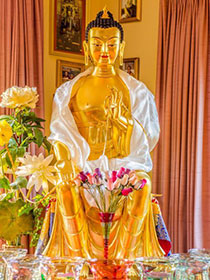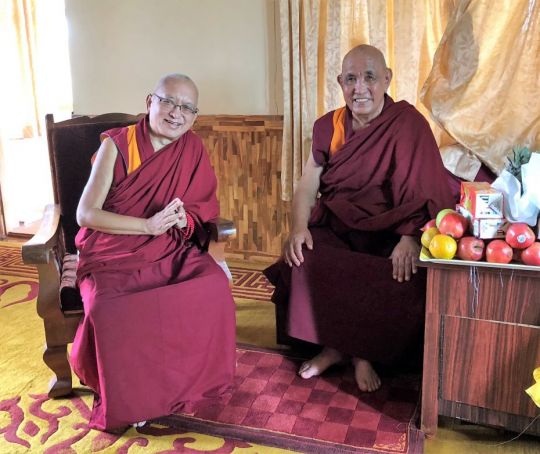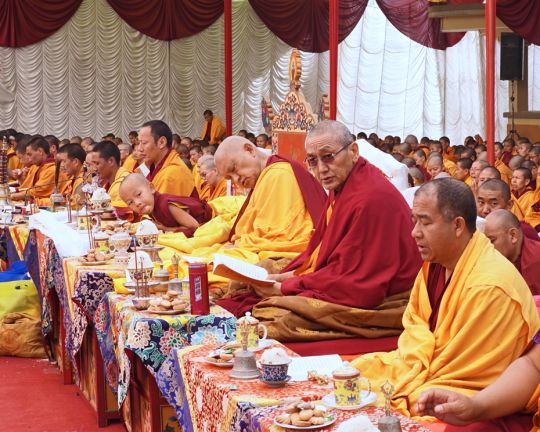- Home
- FPMT Homepage
Foundation for the Preservation of the Mahayana Tradition
The FPMT is an organization devoted to preserving and spreading Mahayana Buddhism worldwide by creating opportunities to listen, reflect, meditate, practice and actualize the unmistaken teachings of the Buddha and based on that experience spreading the Dharma to sentient beings. We provide integrated education through which people’s minds and hearts can be transformed into their highest potential for the benefit of others, inspired by an attitude of universal responsibility and service. We are committed to creating harmonious environments and helping all beings develop their full potential of infinite wisdom and compassion. Our organization is based on the Buddhist tradition of Lama Tsongkhapa of Tibet as taught to us by our founders Lama Thubten Yeshe and Lama Thubten Zopa Rinpoche.
- Willkommen
Die Stiftung zur Erhaltung der Mahayana Tradition (FPMT) ist eine Organisation, die sich weltweit für die Erhaltung und Verbreitung des Mahayana-Buddhismus einsetzt, indem sie Möglichkeiten schafft, den makellosen Lehren des Buddha zuzuhören, über sie zur reflektieren und zu meditieren und auf der Grundlage dieser Erfahrung das Dharma unter den Lebewesen zu verbreiten.
Wir bieten integrierte Schulungswege an, durch denen der Geist und das Herz der Menschen in ihr höchstes Potential verwandelt werden zum Wohl der anderen – inspiriert durch eine Haltung der universellen Verantwortung und dem Wunsch zu dienen. Wir haben uns verpflichtet, harmonische Umgebungen zu schaffen und allen Wesen zu helfen, ihr volles Potenzial unendlicher Weisheit und grenzenlosen Mitgefühls zu verwirklichen.
Unsere Organisation basiert auf der buddhistischen Tradition von Lama Tsongkhapa von Tibet, so wie sie uns von unseren Gründern Lama Thubten Yeshe und Lama Thubten Zopa Rinpoche gelehrt wird.
- Bienvenidos
La Fundación para la preservación de la tradición Mahayana (FPMT) es una organización que se dedica a preservar y difundir el budismo Mahayana en todo el mundo, creando oportunidades para escuchar, reflexionar, meditar, practicar y actualizar las enseñanzas inconfundibles de Buda y en base a esa experiencia difundir el Dharma a los seres.
Proporcionamos una educación integrada a través de la cual las mentes y los corazones de las personas se pueden transformar en su mayor potencial para el beneficio de los demás, inspirados por una actitud de responsabilidad y servicio universales. Estamos comprometidos a crear ambientes armoniosos y ayudar a todos los seres a desarrollar todo su potencial de infinita sabiduría y compasión.
Nuestra organización se basa en la tradición budista de Lama Tsongkhapa del Tíbet como nos lo enseñaron nuestros fundadores Lama Thubten Yeshe y Lama Zopa Rinpoche.
A continuación puede ver una lista de los centros y sus páginas web en su lengua preferida.
- Bienvenue
L’organisation de la FPMT a pour vocation la préservation et la diffusion du bouddhisme du mahayana dans le monde entier. Elle offre l’opportunité d’écouter, de réfléchir, de méditer, de pratiquer et de réaliser les enseignements excellents du Bouddha, pour ensuite transmettre le Dharma à tous les êtres. Nous proposons une formation intégrée grâce à laquelle le cœur et l’esprit de chacun peuvent accomplir leur potentiel le plus élevé pour le bien d’autrui, inspirés par le sens du service et une responsabilité universelle. Nous nous engageons à créer un environnement harmonieux et à aider tous les êtres à épanouir leur potentiel illimité de compassion et de sagesse. Notre organisation s’appuie sur la tradition guéloukpa de Lama Tsongkhapa du Tibet, telle qu’elle a été enseignée par nos fondateurs Lama Thoubtèn Yéshé et Lama Zopa Rinpoché.
Visitez le site de notre Editions Mahayana pour les traductions, conseils et nouvelles du Bureau international en français.
Voici une liste de centres et de leurs sites dans votre langue préférée
- Benvenuto
L’FPMT è un organizzazione il cui scopo è preservare e diffondere il Buddhismo Mahayana nel mondo, creando occasioni di ascolto, riflessione, meditazione e pratica dei perfetti insegnamenti del Buddha, al fine di attualizzare e diffondere il Dharma fra tutti gli esseri senzienti.
Offriamo un’educazione integrata, che può trasformare la mente e i cuori delle persone nel loro massimo potenziale, per il beneficio di tutti gli esseri, ispirati da un’attitudine di responsabilità universale e di servizio.
Il nostro obiettivo è quello di creare contesti armoniosi e aiutare tutti gli esseri a sviluppare in modo completo le proprie potenzialità di infinita saggezza e compassione.
La nostra organizzazione si basa sulla tradizione buddhista di Lama Tsongkhapa del Tibet, così come ci è stata insegnata dai nostri fondatori Lama Thubten Yeshe e Lama Zopa Rinpoche.
Di seguito potete trovare un elenco dei centri e dei loro siti nella lingua da voi prescelta.
- 欢迎 / 歡迎
简体中文
“护持大乘法脉基金会”( 英文简称:FPMT。全名:Foundation for the Preservation of the Mahayana Tradition) 是一个致力于护持和弘扬大乘佛法的国际佛教组织。我们提供听闻,思维,禅修,修行和实证佛陀无误教法的机会,以便让一切众生都能够享受佛法的指引和滋润。
我们全力创造和谐融洽的环境, 为人们提供解行并重的完整佛法教育,以便启发内在的环宇悲心及责任心,并开发内心所蕴藏的巨大潜能 — 无限的智慧与悲心 — 以便利益和服务一切有情。
FPMT的创办人是图腾耶喜喇嘛和喇嘛梭巴仁波切。我们所修习的是由两位上师所教导的,西藏喀巴大师的佛法传承。
繁體中文
護持大乘法脈基金會”( 英文簡稱:FPMT。全名:Found
ation for the Preservation of the Mahayana Tradition ) 是一個致力於護持和弘揚大乘佛法的國際佛教組織。我們提供聽聞, 思維,禪修,修行和實證佛陀無誤教法的機會,以便讓一切眾生都能 夠享受佛法的指引和滋潤。 我們全力創造和諧融洽的環境,
為人們提供解行並重的完整佛法教育,以便啟發內在的環宇悲心及責 任心,並開發內心所蘊藏的巨大潛能 — 無限的智慧與悲心 – – 以便利益和服務一切有情。 FPMT的創辦人是圖騰耶喜喇嘛和喇嘛梭巴仁波切。
我們所修習的是由兩位上師所教導的,西藏喀巴大師的佛法傳承。 察看道场信息:
- FPMT Homepage
- News/Media
-
- Study & Practice
-
-
- About FPMT Education Services
- Latest News
- Programs
- New to Buddhism?
- Buddhist Mind Science: Activating Your Potential
- Heart Advice for Death and Dying
- Discovering Buddhism
- Living in the Path
- Exploring Buddhism
- FPMT Basic Program
- FPMT Masters Program
- FPMT In-Depth Meditation Training
- Maitripa College
- Lotsawa Rinchen Zangpo Translator Program
- Universal Education for Compassion & Wisdom
- Online Learning Center
-
- Prayers & Practice Materials
- Overview of Prayers & Practices
- Full Catalogue of Prayers & Practice Materials
- Explore Popular Topics
- Benefiting Animals
- Chenrezig Resources
- Death & Dying Resources
- Lama Chopa (Guru Puja)
- Lama Zopa Rinpoche: Compendium of Precious Instructions
- Lama Zopa Rinpoche: Life Practice Advice
- Lama Zopa Rinpoche Practice Series
- Lamrim Resources
- Mantras
- Prayer Book Updates
- Purification Practices
- Sutras
- Thought Transformation (Lojong)
- Audio Materials
- Dharma Dates - Tibetan Calendar
- Translation Services
- Publishing Services
- Ways to Offer Support
- Prayers & Practice Materials
-
- Teachings and Advice
- Find Teachings and Advice
- Lama Zopa Rinpoche Advice Page
- Lama Zopa Rinpoche: Compendium of Precious Instructions
- Lama Zopa Rinpoche Video Teachings
- ༧སྐྱབས་རྗེ་བཟོད་པ་རིན་པོ་ཆེ་མཆོག་ནས་སྩལ་བའི་བཀའ་སློབ་བརྙན་འཕྲིན།
- Podcasts
- Lama Yeshe Wisdom Archive
- Buddhism FAQ
- Dharma for Young People
- Resources on Holy Objects
- Teachings and Advice
-
-
*If a menu item has a submenu clicking once will expand the menu clicking twice will open the page.
-
-
- Centers
-
- Teachers
-
- Projects
-
-
-
-
*If a menu item has a submenu clicking once will expand the menu clicking twice will open the page.
-
-
- FPMT
-
-
-
-
-
The most happy thing in my life, most fulfilling thing is to work for and to benefit sentient beings. Even just the mere thought to cause happiness to sentient beings, to benefit them, to free them from suffering is the BEST offering to all the buddhas and bodhisattvas. This is the best offering, the best puja; this is what pleases their holy mind most.
Lama Zopa Rinpoche
-
-
-
- Shop
-
-
-
The Foundation Store is FPMT’s online shop and features a vast selection of Buddhist study and practice materials written or recommended by our lineage gurus. These items include homestudy programs, prayers and practices in PDF or eBook format, materials for children, and other resources to support practitioners.
Items displayed in the shop are made available for Dharma practice and educational purposes, and never for the purpose of profiting from their sale. Please read FPMT Foundation Store Policy Regarding Dharma Items for more information.
-
-
FPMT Community: Stories & News
2
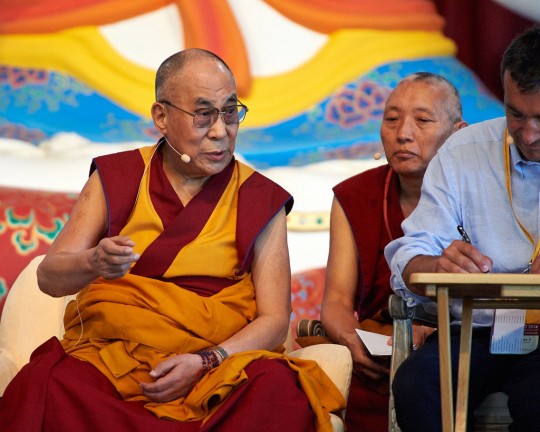
His Holiness the Dalai Lama teaching at Istituto Lama Tzong Khapa with Geshe Tashi Tsering, resident geshe at Jamyang Buddhist Centre, and Fabrizio Palliotti, providing interpretation, Pomaia, Italy, June 13, 2014. Photo by Olivier Adam.
His Holiness the Dalai Lama has appointed Geshe Tashi Tsering abbot of Sera Mey Monastery in Bylakuppe, South India. A long-time FPMT resident teacher, Geshe Tashi Tsering will be relocating from the UK to India, returning to the monastery where he began his monastic education.
Born in Purang, Tibet, in 1958, Geshe Tashi Tsering and his parents fled to India one year later. He entered Sera Mey Monastery in Bylakuppe, South India, at the age of thirteen. After receiving his Geshe Lharamapa degree from Sera Mey Monastery in 1987, he studied at Gyuto Tantric College for another year.
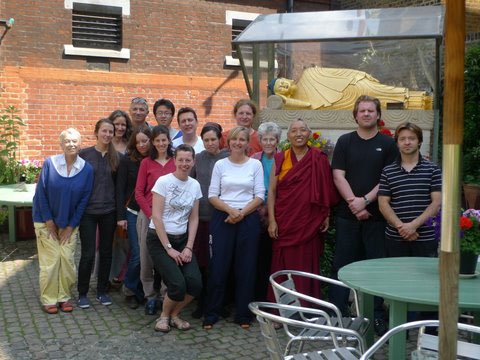
Medicine Buddha Retreat with Geshe Tashi Tsering, UK, 2017. Photo courtesy of Jamyang Buddhist Centre’s Facebook page.
Geshe Tashi Tsering has been teaching at FPMT centers for more than twenty-five years. In 1994, after teaching at Nalanda Monastery in France for several years, Geshe Tashi Tsering became the resident teacher at FPMT center Jamyang Buddhist Centre in London, England.
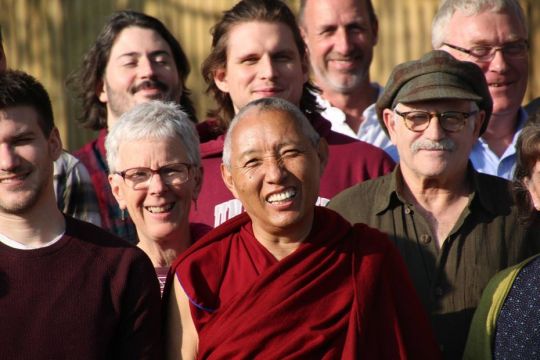
Geshe Tashi Tsering with students, UK. Photo courtesy of Jamyang Buddhist Center Leeds’ Facebook page.
In addition to teaching in London, Geshe Tashi Tsering travels to teach at other FPMT centers and study groups in the UK.
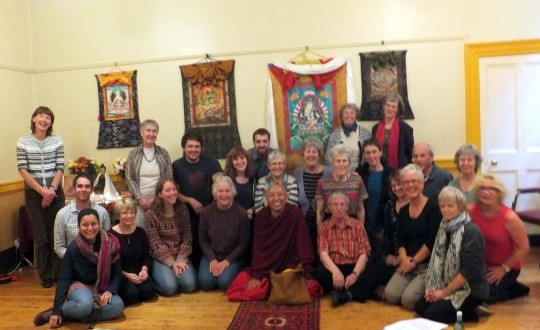
Geshe Tashi Tsering teaches on buddha nature to the students of Jamyang Bath Study Group, UK, October 2014. Photo courtesy of Sandra Whilding.
His willingess to travel to Leeds, UK, to teach enabled FPMT center Jamyang Leeds to establish itself twenty-one years ago.

Retreat with Geshe Tashi Tsering, UK, 2011. Photo courtesy of Jamyang Centre Leeds’ Facebook page.
Geshe Tashi Tsering has created The Foundation of Buddhist Thought, a two-year, six-module correspondence course. He is the author of a six-volume series by the same name, published by Wisdom Publications.
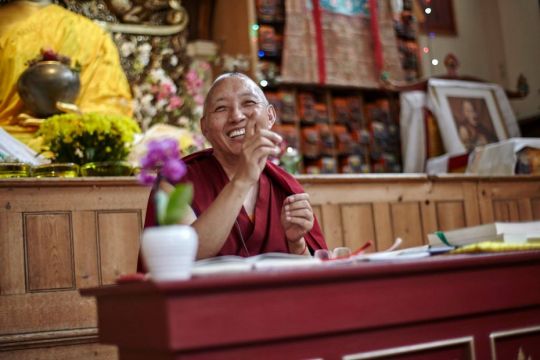
Geshe Tashi Tsering teaching at Jamyang Buddhist Center, UK. Photo courtesy of Jamyang Buddhist Centre’s Facebook page.
To learn more about FPMT’s study programs visit:
https://fpmt.org/education/programs/
FPMT.org brings you news of Lama Zopa Rinpoche and of activities, teachings and events from over 160 FPMT centers, projects and services around the globe. If you like what you read, consider becoming a Friend of FPMT, which supports our work.
- Tagged: geshe tashi tsering, jamyang bath, jamyang buddhist centre, jamyang buddhist centre leeds, sera mey monastery
25
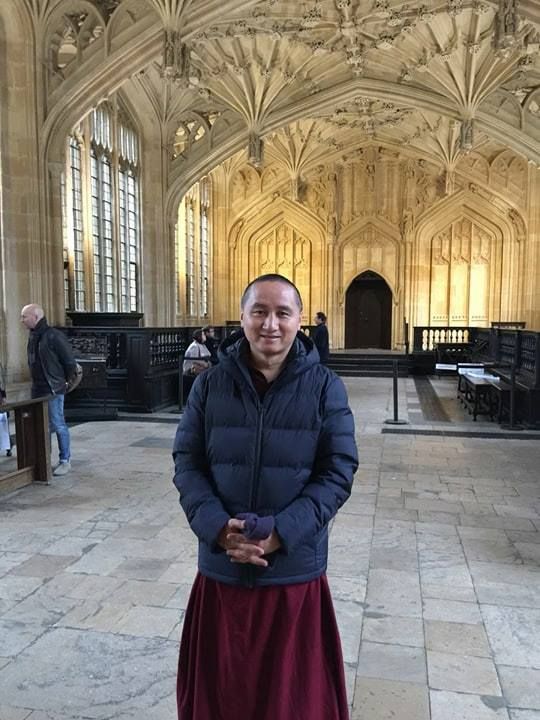
Geshe Tenzin Zopa at Oxford University, Oxford, UK, January 2018. Photo courtesy of FPMT Australia’s Facebook page.
FPMT touring teacher Geshe Tenzin Zopa recently completed an eight-week So-Wide Visitorship for Traditional Scholars in the Tibetan and Himalayan Studies program, part of the Faculty of Oriental Studies at Oxford University in the UK.
A small group of master’s and doctoral students in the Tibetan and Himalayan Studies program are learning the Tibetan language so that they can work with Tibetan texts. Geshe Tenzin Zopa met with a group of students once per week for eight weeks, guiding them through the reading of a Tibetan text. He was also busy giving public talks, meeting with students to discuss their projects, and leading meditations. The students also had the opportunity to watch the film Unmistaken Child.
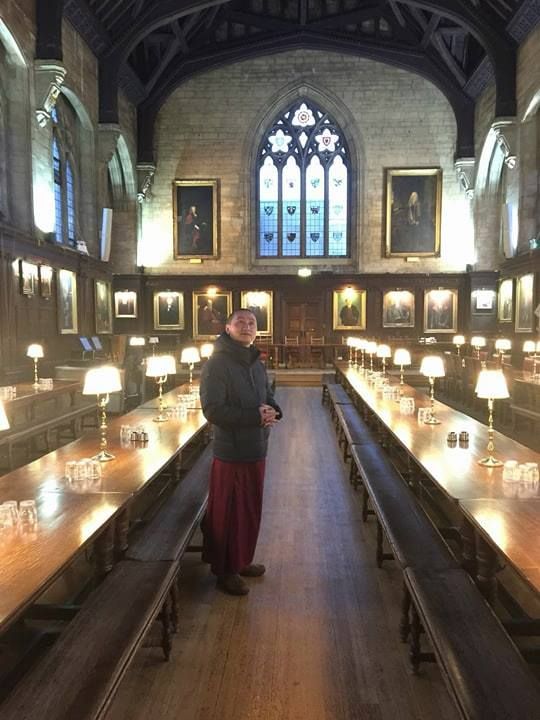
Geshe Tenzin Zopa at Oxford University, Oxford, UK, January 2018. Photo courtesy of FPMT Australia’s Facebook page.
Geshe Tenzin Zopa spent some time getting to know the Oxford faculty and their teaching styles through attending lectures.
The Visitorship was offered to Geshe Tenzin Zopa by the nonprofit So-Wide (The Society for the Wider Understanding of the Buddhist Tradition) in association with the Oxford Centre for Buddhist Studies and the Faculty of Oriental Studies at Oxford University.
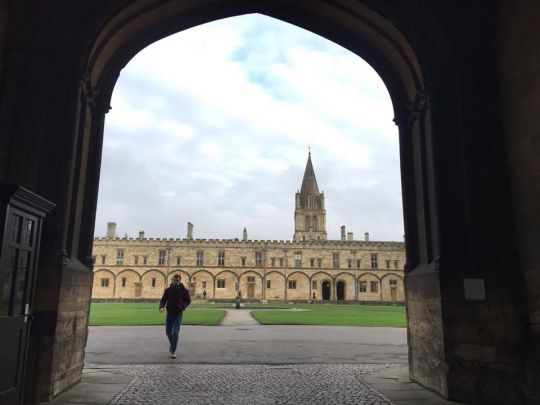
Oxford University campus, Oxford, UK, January 2018. Photo courtesy of Geshe Tenzin Zopa’s Facebook page.
While at Oxford, Geshe Tenzin Zopa resided at the Oxford Buddha Vihara, but traveled the UK to give talks at FPMT centers.
In March, Geshe Graham Woodhouse and former Jamyang center director Marcos Troia traveled to Oxford for Geshe Tenzin Zopa’s farewell event. They attended a talk he gave to thirty people about the traditional monastic system and Sera Je Monastery. Geshe Graham Woodhouse contributed his experience as a Westerner in India. Geoff Bamford, who organized the Visitorship for Geshe Tenzin Zopa on behalf of the Oxford Centre for Buddhist Studies and So-Wide, also spoke at the event.
Reflecting on his experience at Oxford, Geshe Tenzin Zopa had this to share:
“Om Ah Hum! … After learning a bit of history about how this place has developed as a great learning institution, it reminds me in many ways of, and makes me feel a deep appreciation for, the great ancient Nalanda University in ancient India, as well as the Tibetan monastic universities like Sera.
“It made me feel so proud of myself and those who have had the privilege of studying in great monastic universities like Sera, Drepung, and Ganden. We are so extremely fortunate to have such extraordinary learning institutions within the Tibetan Buddhist tradition. Rejoice, rejoice, we must rejoice.”
Geshe Tenzin Zopa is now attending Lama Zopa Rinpoche’s Bodhicaryavatara and Rinjung Gyatsa Retreat at The Great Stupa of Universal Compassion in Bendigo, Australia.

Geshe Tenzin Zopa with Lama Zopa Rinpoche, Bendigo, Australia, April 2018. Photo by Ven. Roger Kunsang.
Watch Lama Zopa Rinpoche teach during the Bodhicaryavatara and Rinjung Gyatsa Retreat at The Great Stupa of Universal Compassion in Bendigo, Australia, March 30-May 12, 2018.
- Find links to watch teachings LIVE:
https://fpmt.org/media/streaming/lama-zopa-rinpoche-live/ - Watch, read, and listen to all of Rinpoche’s teachings from Bendigo at anytime:
https://fpmt.org/media/streaming/teachings-of-lama- zopa-rinpoche/
FPMT.org brings you news of Lama Zopa Rinpoche and of activities, teachings and events from over 160 FPMT centers, projects and services around the globe. If you like what you read, consider becoming a Friend of FPMT, which supports our work.
- Tagged: Geshe Tenzin Zopa, oxford university
21
New Video: Merit in a Circle
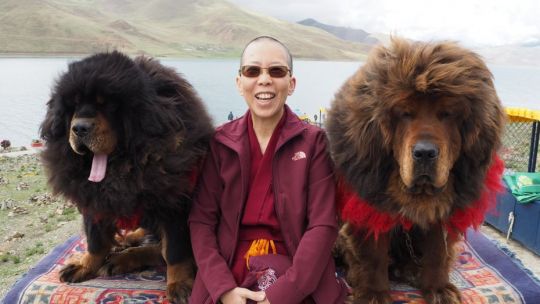
Ven. Tenzin Tsultrim partakes in a souvenir photo session with two Tibetan mastiffs beside Yamdrok Lake, en route to Shigatse, Tibet, June 2017. Photo courtesy of Ven. Tenzin Tsultrim.
Ven. Tenzin Tsulrim, a long-time member and student at FPMT Center Amitabha Buddhist Centre in Singapore, shares a video she made in 2017 about her practice of circumambulation around holy objects:
Since receiving ordination from His Holiness the Dalai Lama in March 2009, I have served ABC in various ways, including as media editor and video producer. Currently, I lead the on-going Medicine Buddha, Tara, and Guru pujas at ABC, and am a student in the FPMT Basic Program.
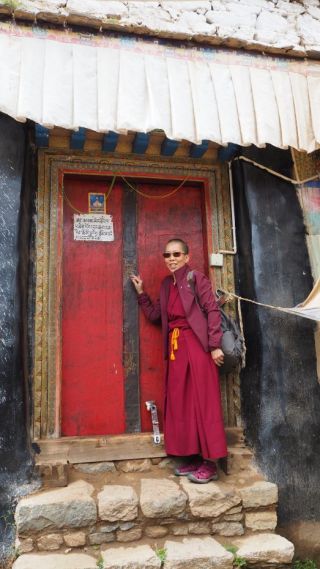
Ven. Tenzin Tsultrim outside of Lama Tsongkhapa’s retreat hermitage above Reting Monastery where he composed Lamrim Chenmo, Tibet, June 2017. Photo courtesy of Ven. Tenzin Tsultrim.
By watching this video, made using a pocket-sized video camera over an eight-month period, you can follow me as I traverse several sacred Buddhist sites across Asia in footsteps that pay homage to the Buddhist practice of circumambulation and its significance for enabling all sentient beings to accumulate merit. From one degree north of the equator in Singapore, to the high altitudes of Tibet, my path traces a circle inspired by unity and hope.
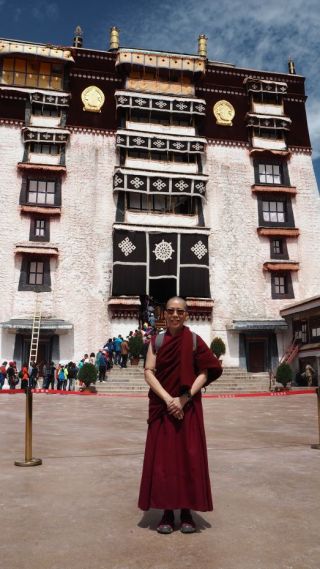
Ven. Tenzin Tsultrim at the inner courtyard of the Potala Palace in Lhasa, Tibet, June 2017. Photo courtesy of Ven. Tenzin Tsultrim.
Creating the video was as much an exploratory journey for me as the actual pilgrimages I made to the holy places and doing the circumambulations. I hope by watching this video many people will be inspired to visit these precious places, and create their own circles of merit!
Watch Ven. Tenzin Tsultrim’s video on circumambulation here:
https://youtu.be/5JUjEhcBsqg
Lama Zopa Rinpoche’s Advice on Circumambulation, compiled by Ven. Sarah Thresher, is available for download through the FPMT Foundation Store:
https://shop.fpmt.org/Circumambulation–Lama-Zopa-Rinpoches-Advice-PDF_p_2149.html
FPMT.org and Mandala Publications brings you news of Lama Zopa Rinpoche and of activities, teachings, and events from over 160 FPMT centers, projects, and services around the globe. If you like what you read, consider becoming a Friend of FPMT, which supports our work.
- Tagged: circumambulation, ven. tenzin tsultrim
20
We hope you enjoy the April edition of the FPMT International Office e-News!
This month we bring you:
- Updates to Rinpoche’s schedule, including an initiation particularly beneficial to those serving in the organization;
- New materials from Education Services;
- More to rejoice about, including news about a recent Foundation Service Seminar, and dates of upcoming FPMT Service Seminars!
… and more!
The FPMT International Office News comes from your FPMT International Office. Visit our subscribe page to receive the FPMT International Office News directly in your email box.
18
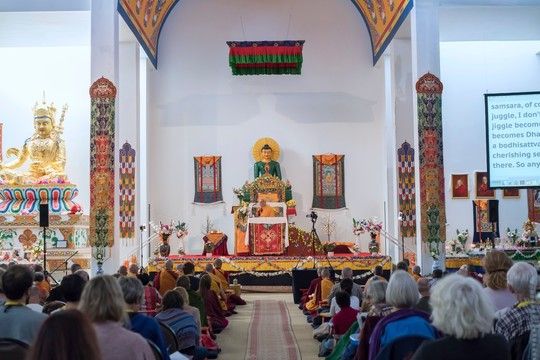
Lama Zopa Rinpoche teaching at The Great Stupa of Universal Compassion, Bendigo, Australia, April 2018. Photo by Ven. Lobsang Sherab.
Lama Zopa Rinpoche is currently leading the Bodhicaryavatara and Rinjung Gyatsa Retreat at the Great Stupa of Universal Compassion in Bendigo, Australia. The six-week retreat began on March 30 and is scheduled to conclude on May 12, 2018.
Lama Zopa Rinoche is teaching on Shantideva’s A Guide to the Bodhisattva’s Way of Life and will give the optional tantric empowerments of Chakrasamvara and Rinjung Gyatsa. This is Rinpoche’s third teaching retreat on this topic in Australia, having commenced in 2011.
Ian Green, director of The Great Stupa of Universal Compassion, shares details about preparations made in advance of the retreat:
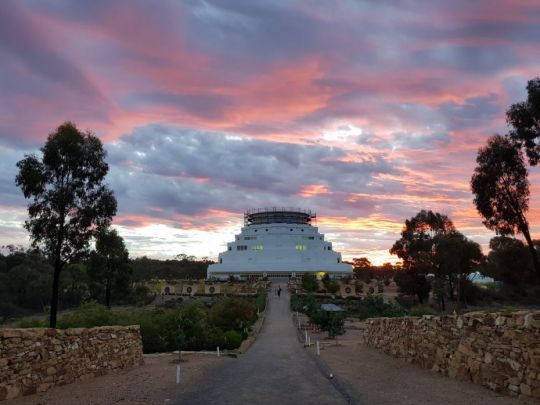
The Great Stupa of Universal Compassion at sunset, Bendigo, Australia, March 2018. Photo courtesy of Ian Green’s Twitter page.
Preparations for Lama Zopa Rinpoche’s retreat inside of The Great Stupa of Universal Compassion, Bendigo, Australia was a complicated logistical exercise.
Eighteen months before the retreat, we set up massive scaffolding inside of The Great Stupa, which stood fourteen meters tall by twenty meters wide (forty-six feet tall by sixty-six feet wide). Once the scaffolding was in place we began our work finishing the walls, light wells, and main arch of the north side of the gompa. That construction work took more than twelve months.
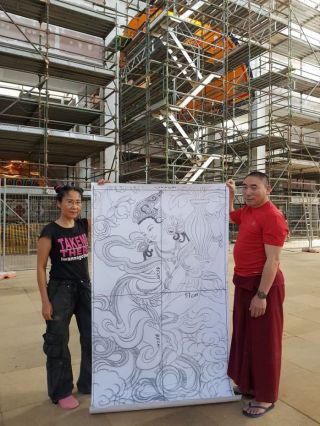
Lucy Wang and Ven. Lobsang Konchok holding an image of a dakini inside of The Great Stupa, Bendigo, Australia, January 2018. Photo courtesy of Ian Green’s Twitter page.
The next phase was the creation of the artwork following Lama Zopa Rinpoche’s advice, by highly skilled Tibetan artist Ven. Lobsang Konchok.
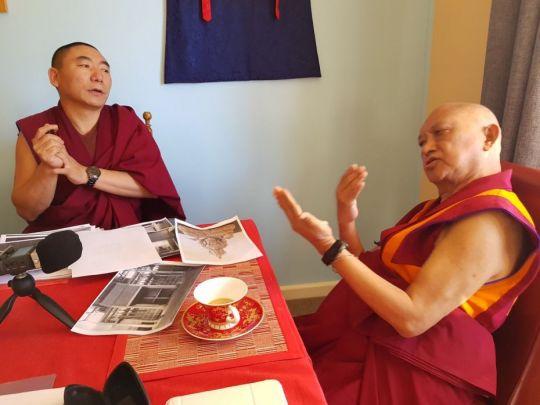
Lama Zopa Rinpoche and Ven. Lobsang Konchok discussing artwork for The Great Stupa, Bendigo, Australia, April 2018. Photo courtesy of Ian Green’s Twitter page.
It took Ven. Lobsang Konchok and his assistant Lucy Wang six months to paint the eight by six meter (twenty-six by twenty foot) arch. The result is a spectacular presentation of the Dharmachakra surrounded by eight offering dakinis.
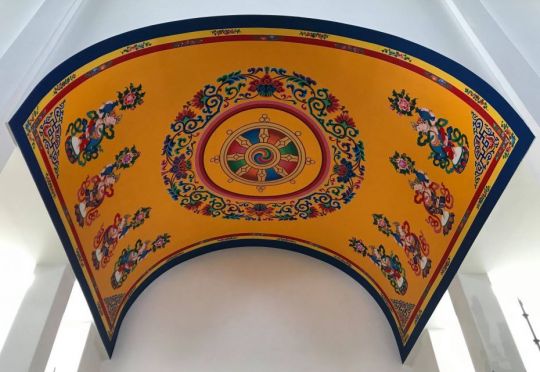
The Dharmachakra surrounded by eight offering dakinis in The Great Stupa, Bendigo, Australia, March 2018. Photo courtesy of The Great Stupa of Universal Compassion’s Facebook page.
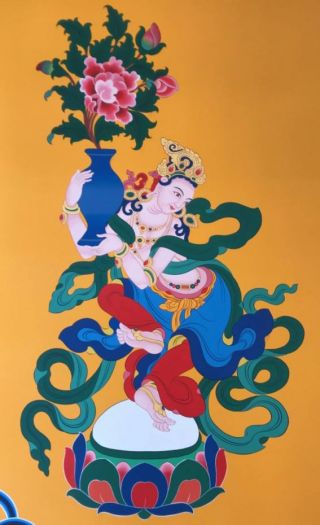
One of the eight offering dakinis adorning the arch inside of The Great Stupa, Bendigo, Australia, March 2018. Photo courtesy of The Great Stupa of Universal Compassion’s Facebook page.
While the Tibetan artwork was being completed twelve meters (thirty-nine feet) above the floor, plasterers and painters were at work on the lower levels. The last paint strokes were made two weeks prior to the commencement of the retreat.
The next phase was the dismantling of the scaffolding. This took one week.
Ten days prior to the start of the retreat, we were well into the massive clean-up phase. We devoted the final week to decorating The Great Stupa’s gompa with holy artwork.
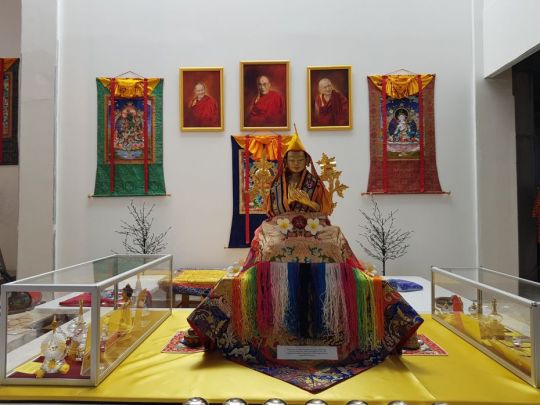
Holy relics set up inside of The Great Stupa, Bendigo, Australia, March 2018. Photo courtesy of Ian Green’s Twitter page.
Since the retreat began, Lama Zopa Rinpoche has viewed relics displayed inside of The Great Stupa, teaching how to transform difficult situations into the path by seeing the benefits and training the mind.
The most spectacular artwork inside of the gompa is the fourteen-meter (forty-six foot) high thangka of the Twenty-One Taras.

The Twenty-One Taras thangka done by Peter Iseli on display inside of The Great Stupa, Bendigo, Australia, April 2018. Photo by Ven. Lobsang Sherab.
The thangka was created by artist Peter Iseli, commissioned by Lama Zopa Rinpoche for Tara Institute, the FPMT center in Melbourne, Australia.

Peter Iseli, Ven. Lobsang Konchok, Jangchub Iseli, and Ven. Thubten Gyatso at The Great Stupa, Bendigo, Australia, February 2018. Photo courtesy of Ian Green’s Twitter page.
Heath Penbrook, marketing and events coordinator for The Great Stupa of Universal Compassion shares about the return of the Jade Buddha for Universal Peace to The Great Stupa of Universal Compassion:
The Jade Buddha for Universal Peace is the largest Buddha carved from gemstone quality jade in the world. The size and beauty of the statue makes it a wonder of the world. The Buddha was carved from a rare boulder of translucent jade (“Polar Pride”), which was discovered in Canada in 2000.
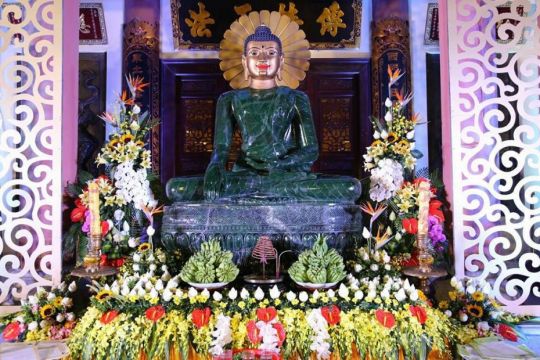
The Jade Buddha surrounded by floral offerings after the unveiling at Yen Phu Temple, Hanoi, Vietnam, June 2016. Photo courtesy of Ian Green’s Twitter page.
The Jade Buddha is 2.5 meters (eight feet) high and sits on an alabaster throne of close to 1.6 meters (five feet) high. The Jade Buddha itself weighs around four tonnes (8,800 pounds) and is considered to be priceless.
The Jade Buddha finished the final leg of its nine-year world tour in South Korea in early March.

A Buddhist nun and young girl with the Jade Buddha, Busan, South Korea, March 2018. Photo courtesy of Ian Green’s Twitter page.
Ian Green flew over to South Korea to ensure the safe packaging and shipping of the Jade Buddha to its home at The Great Stupa in Bendigo, Australia.
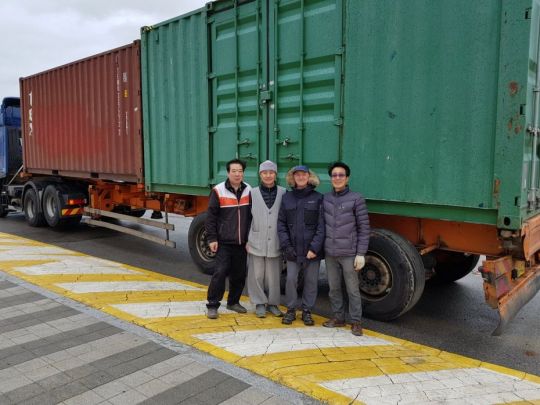
Ian Green and friends with the Jade Buddha, packed and ready for shipment, Busan, South Korea, March 2018. Photo courtesy of Ian Green’s Twitter page.
We expect the Jade Buddha to arrive in mid-April during the Bodhicaryavatara and Rinjung Gyatsa Retreat at The Great Stupa of Universal Compassion. We are hoping to be able to place the Jade Buddha upon its throne and consecrate it during the retreat, thereby welcoming the Jade Buddha to its new home.
To learn more about The Great Stupa of Universal Compassion and the Jade Buddha for Universal Peace visit the website:
https://www.stupa.org.au
Watch Lama Zopa Rinpoche teach during the Bodhicaryavatara and Rinjung Gyatsa Retreat at The Great Stupa of Universal Compassion in Bendigo, Australia, March 30-May 12, 2018.
- Find links to watch teachings LIVE:
https://fpmt.org/media/streaming/lama-zopa-rinpoche-live/ - Watch, read, and listen to all of Rinpoche’s teachings from Bendigo at anytime:
https://fpmt.org/media/streaming/teachings-of-lama- zopa-rinpoche/
Lama Zopa Rinpoche is the spiritual director of the Foundation for the Preservation of Mahayana Tradition (FPMT), a Tibetan Buddhist organization dedicated to the transmission of the Mahayana Buddhist tradition and values worldwide through teaching, meditation, and community service.
- Tagged: australia retreat 2018, great stupa of universal compassion, heath penbrook, ian green, jade buddha for universal peace, lucy wang, peter iseli, ven. lobsang konchok
11
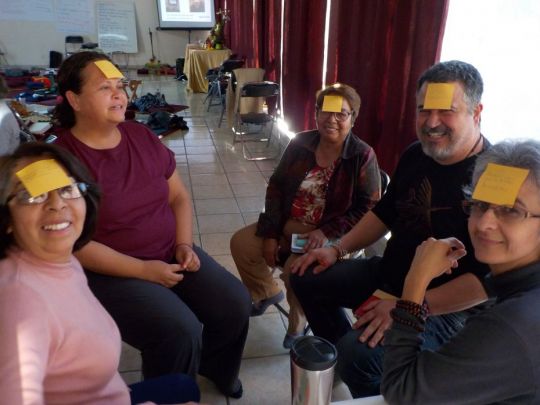
Foundation Service Seminar in Guadalajara, Mexico, February 2018. Photo courtesy of Gilda Urbina.
FPMT service seminars provide support and training to those offering service, and those wishing to offer service, within FPMT centers, services, and projects. The seminars help develop a shared understanding of the FPMT mission set out by Lama Thubten Yeshe and Lama Zopa Rinpoche, and a firm basis to serve effectively and joyfully within the organization.
Gilda Urbina, Foundation Service Seminar registered facilitator and FPMT Mexico National Coordinator, shares her story about the recent Foundation Service Seminar that took place in Mexico in February 2018:
We had the great opportunity to participate in the Foundation Service Seminar (FSS) in Guadalajara, Mexico. It was attended by twenty-six volunteers from four centers and five FPMT study groups in Mexico.
It was facilitated by François Lecointre, a senior FSS registered facilitator and director of Institut Vajra Yogini. His kind and lovely presence helped to create a relaxed and yet attentive environment. With his help, Mar Portillo and I, as facilitators-in-training felt confident and motivated to keep on learning the “know how” of this noble activity.
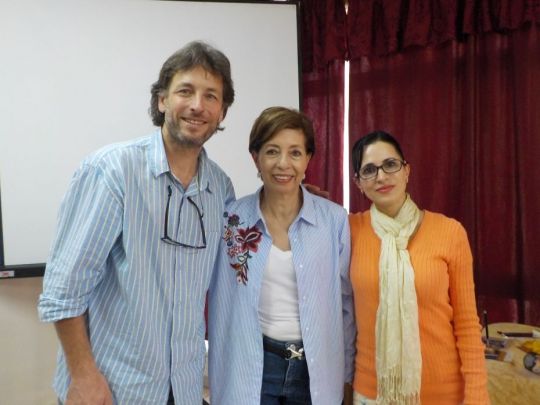
Foundation Service Seminar facilitators François Lecointre, Gilda Urbina, and Mar Portillo in Guadalajara, Mexico, February 2018. Photo courtesy of Gilda Urbina.
In an environment of great harmony and joy, we analyzed and deepened our understanding of the valuable information offered to us through the FSS. Through observing the groups, I could see there was a spirit of teamwork and collaboration.
While working in the groups, participants were able to review the functioning of their FPMT center or study group, recognize areas of opportunity, and generate new ideas to further professionalize their work.
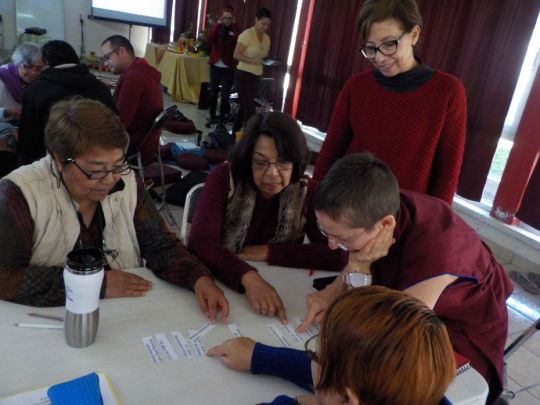
Foundation Service Seminar in Guadalajara, Mexico, February 2018. Photo courtesy of Gilda Urbina.
I could see that the people attending the FSS have a deep devotion to Lama Zopa Rinpoche, as well as a desire to contribute to his Vast Visions. Together, we reached specific conclusions regarding actions we can take that are consistent with the four skillful means to draw beings to the Dharma.
Through participating in the FSS, we gained clear ideas for how we can better welcome and engage new people who come to FPMT centers and study groups.
We also reviewed the Inner Job Description, which is an invaluable tool reminding us to go within ourselves and keep practicing, so we can benefit others through example.
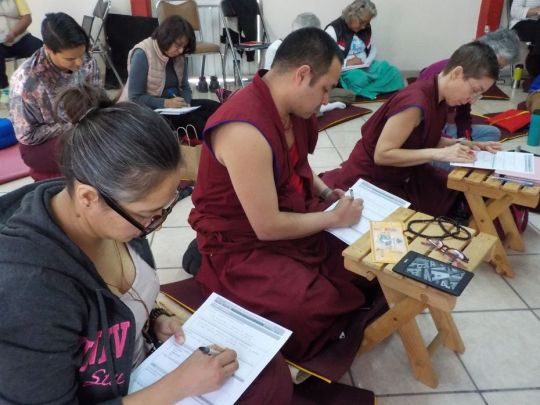
Foundation Service Seminar in Guadalajara, Mexico, February 2018. Photo courtesy of Gilda Urbina.
When we heard about the amazing activities performed by FPMT centers, projects, and services around the world we were all inspired, and rejoiced.
Moreover, the information offered about FPMT programs and to teach according to the level of the student was an excellent aid for those of us organizing the teaching program at FPMT centers and study groups.
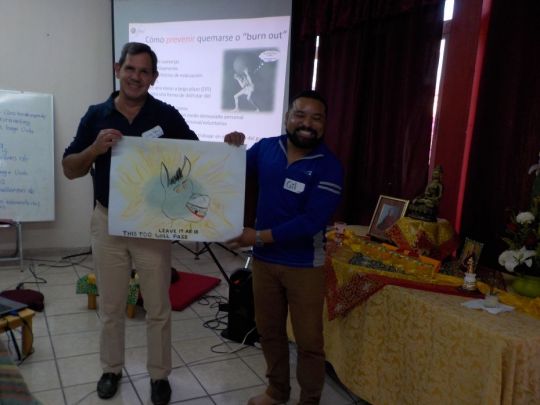
Foundation Service Seminar in Guadalajara, Mexico, February 2018. Photo courtesy of Gilda Urbina.
In summary, the FSS was an invaluable learning experience where the family feeling was always present. All agreed that these tools will definitely help us as we strive to professionalize our internal work; our work for the centers and study groups; and encourage us to work in a harmonious environment.
I am so grateful to be a part of the FPMT family.
For more information on the Foundation Service Seminar and to find out how to register for future events, visit the FPMT Service Seminar webpage:
https://fpmt.org/education/training/
FPMT.org and Mandala Publications brings you news of Lama Zopa Rinpoche and of activities, teachings, and events from over 160 FPMT centers, projects, and services around the globe. If you like what you read, consider becoming a Friend of FPMT, which supports our work.
- Tagged: foundation service seminar, fpmt mexico, gilda urbina, mexico
4
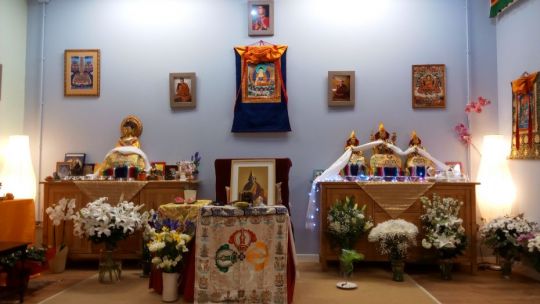
Centro La Sabiduría de Nagarjuna has a new center, Bilbao, Spain, February 2018. Photo by Centro La Sabiduría de Nagarjuna community.
FPMT center Centro La Sabiduría de Nagarjuna (Nagarjuna’s Wisdom Center) in Bilbao, Spain, began as an FPMT study group in December 2012 with four members. They affiliated and became an FPMT center in April 2016, and now have twenty-five members.
In December 2017, Centro La Sabiduría de Nagarjuna moved out of the space they had occupied for the previous three years in preparation for a move to a new home. Center director Koke Muro brings us the news:
We are delighted to share with you that on Saturday, February 24, 2018, we inaugurated our new center in Bilbao, Spain.
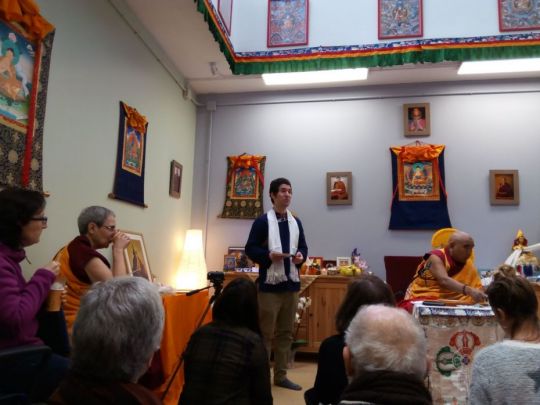
Geshe Lamsang, center director Koke Muro, and guests during the inauguration of Centro La Sabiduría de Nagarjuna’s new center, Bilbao, Spain, February 2018. Photo by Centro La Sabiduría de Nagarjuna community.
Over the past five years since our founding, thanks to our amazing members, volunteers, and benefactors, as well as the kind care and guidance of our dear lamas and teachers, the center has been developing and blossoming like a beautiful flower.
The old center was getting too small to host all of the beautiful people and holy objects, and it was on the third floor of a business building. Following the advice of our most kind Lama Zopa Rinpoche, we started looking for another place. We feel really fortunate that this amazing location appeared. Our new center exists due to the enthusiastic work of many, many people. Our wish is that it becomes a source of peace in the city for everyone.
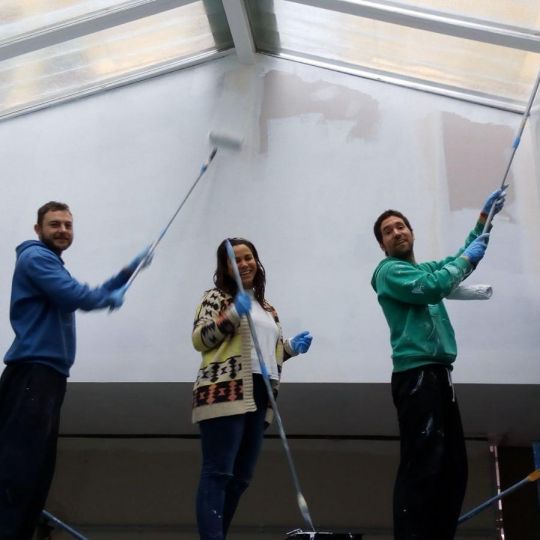
Volunteers painting the ceiling of Centro La Sabiduría de Nagarjuna’s new center, Bilbao, Spain, February 2018. Photo courtesy of Centro La Sabiduría de Nagarjuna’s Facebook page.
After nine months of hard work—and thanks to the unbelievable kindness of our lamas, more than two hundred benefactors, and an amazing team of volunteers—we had a great weekend.
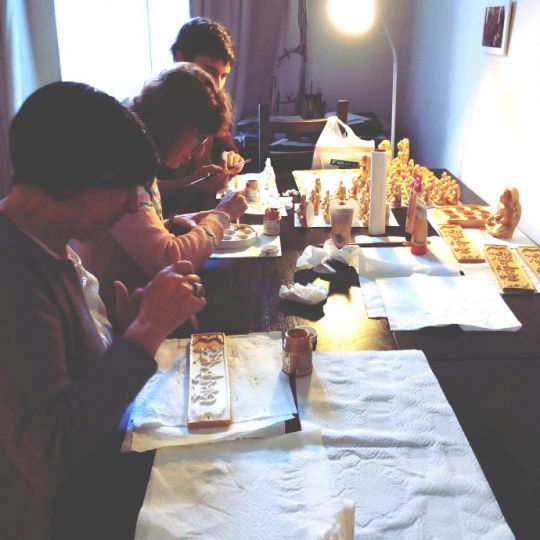
Centro La Sabiduria de Nagarjuna volunteers preparing for the inauguration, Bilbao, Spain, February 2018. Photo by Centro La Sabiduria de Nagarjuna community.
Geshe Lamsang, resident teacher at Centro Nagarjuna Valencia, consecrated our new center. We also began the lamrim module of the Basic Program, taught by Geshe Lamsang that same day.
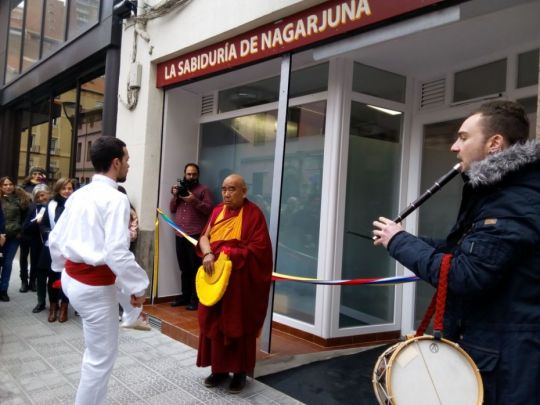
Geshe Lamsang in front of the entrance to Centro La Sabiduría de Nagarjuna, Bilbao, Spain, February 2018. Photo courtesy of Centro La Sabiduría de Nagarjuna’s Facebook page.
We enjoyed traditional welcome dances, food, a touching video about the volunteers who made our move possible, songs, gifts for everyone, and lots of tears of happiness and rejoicing. The joy was shared by the nearly fifty people who attended our inauguration, including members from other Dharma centers.
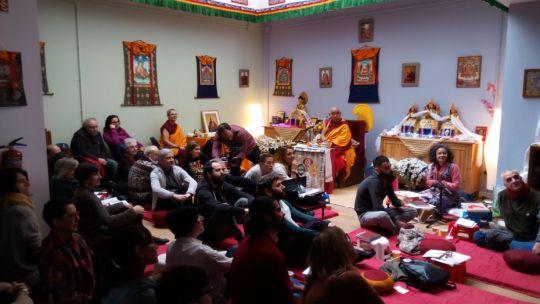
Centro La Sabiduría de Nagarjuna has a new center, Bilbao, Spain, February 2017. Photo by Centro La Sabiduría de Nagarjuna community.
It was an unforgettable day. We want offer all this to our precious guru Lama Zopa Rinpoche so we can always please him and follow his advice for the sake of all beings. Thank you, thank you, thank you, Lama Zopa Rinpoche. Please come soon!
To learn more about Centro La Sabiduría de Nagarjuna visit the center’s website. Watch the video about the volunteers who made their move possible:
https://youtu.be/Lm5gzyc8VvM
FPMT.org and Mandala Publications brings you news of Lama Zopa Rinpoche and of activities, teachings and events from over 160 FPMT centers, projects and services around the globe. If you like what you read, consider becoming a Friend of FPMT, which supports our work.
28
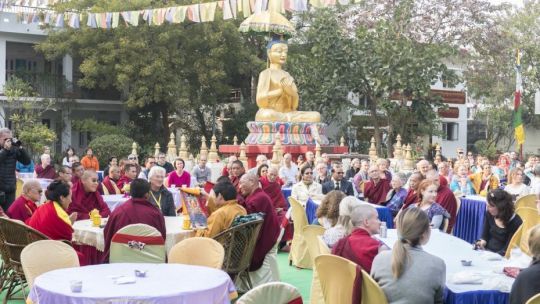
Root Institute thirtieth anniversary celebration, Bodhgaya, India, January 2018. Photo by Ven. Lobsang Sherab.
On January 14, 2018, FPMT center Root Institute for Wisdom Culture celebrated its thirtieth anniversary, which occurred on May 27, 2017.
Over 150 guests attended the event, including Ling Rinpoche, Lama Zopa Rinpoche, Khadro-la (Rangjung Neljorma Khandro Namsel Drönme), Dagri Rinpoche, Tsenshap Serkong Rinpoche, Ribur Rinpoche’s reincarnation, and Geshe Sengye’s reincarnation. Also in attendance were visiting dignitaries including Richard Gere, Root Institute’s resident geshe Geshe Ngawang Rabga, other visiting geshes and lamas, the FPMT Sangha and lay community, as well as a group of pilgrims who had recently completed Root Institute’s first meditative pilgrimage to the eight holy sites of the Buddha.
During the event, Ven. Kabir Saxena, Root Institute’s first director, recalled when Lama Zopa Rinpoche came to Root Institute in 1989 to give his first teaching there:
“When we first brought Rinpoche to the land, we were walking down the path and Rinpoche looked in the distance. It was all fields in those days and Rinpoche said, ‘Oh, it’s like the beach here, it’s like the beach. You know, it’s kind of very relaxed.’ But then immediately Rinpoche said, ‘But we don’t come with the attitude of going to the beach.’ And as soon as Rinpoche came to the gates (well, there weren’t gates there in those days), Rinpoche blew a conch shell very loudly. I think that that Dharma is still reverberating now.”
Ven. Kabir Saxena continued, “I remember once when His Holiness the Karmapa came, he said, ‘So many blessings on this land. This land has so many blessings, you don’t realize it.’ By then, His Holiness the Dalai Lama and many of the great lamas had already been here.”
Current director Ven. Tenzin Paldron thanked Root Institute’s local Indian staff for their tireless years of service and reminded guests of the contributions of the Indian people to the center. “As Sahid our foreman, who has worked at Root for over twenty years, said to me, ‘Madam, directors come and go, but it is the Indian staff that have been the main branches of Root.’”
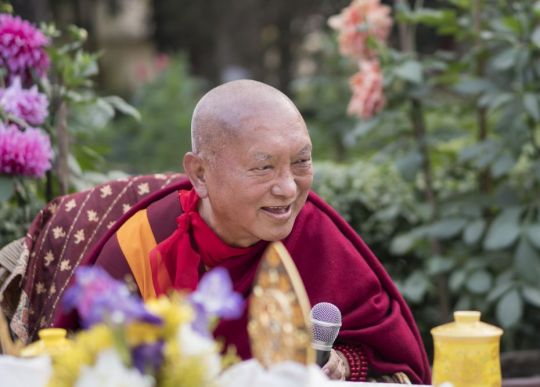
Lama Zopa Rinpoche during Root Institute’s thirtieth anniversary celebration, Bodhgaya, India, January 2018. Photo by Ven. Lobsang Sherab.
Lama Zopa Rinpoche spoke on Root Institute’s contributions to sentient beings. “By teaching lamrim and so forth, they liberate sentient beings from samsara.”
“Because we have been in samsara, the lower realms have been our resident home from beginningless rebirths. This time we have received a perfect human rebirth and an opportunity to no longer be in samsara and suffer. Dharma centers are so important; there are many teachers in the center teaching the philosophy, lamrim. Basically, all to subdue the mind.”
He added, “Not only that, but they teach the Mahayana teachings, bodhichitta, the Mayahana path to peerless happiness, liberation, cessation, and the completion of realizations, causing sentient beings to acheive enlightenment. That’s what the center does; that’s what Root Institute does.”
Filmmaker Marc Israel documented Root Institute’s rich history and ongoing activites—including service projects Shakyamuni Buddha Health Care Clinic, Maitreya School, Tara Children’s Project, and spiritual programs—and its vision for the future in a seventeen-minute film premiered at the celebration.
Watch “ROOT INSTITUTE: From The Ground Up” on YouTube:
https://youtu.be/g9ipm09qXLs
To read more about the Root Institute’s history and spiritual programs offerings, visit the center’s website:
http://www.rootinstitute.ngo/
To watch the thirtieth anniversary celebration, including remarks by Lama Zopa Rinpoche, you can watch Bill Kane’s recording of the event:
https://youtu.be/QxIfNF2H9KQ
FPMT.org and Mandala Publications brings you news of Lama Zopa Rinpoche and of activities, teachings and events from over 160 FPMT centers, projects and services around the globe. If you like what you read, consider becoming a Friend of FPMT, which supports our work.
- Tagged: marc israel, root institute, video, video short
23
A new 15-minute video captures the sounds and scenes of a beautiful and auspicious 100,000 tsog offerings event for Guru Rinpoche done at Khachoe Ghakyil Ling, also called Kopan Nunnery, in December 2017. The Guru bumtsog took place in conjunction with the display of an enormous Guru Rinpoche (Padmasambhava) thangka. The new video shares detailed images of the thangka, extensive offerings, and puja.
This was the third year that the very large thangka was displayed at the nunnery with a Guru bumstog. The thangka, which is 75 feet (23 meters) high and 87 feet (27 meters) wide, hung from a large scaffolding and depicts in stitched appliqué the Padmasambhava merit field in the center.
Lama Zopa Rinpoche attended the event with Khen Rinpoche Geshe Chonyi, who is the current abbot of the nunnery, and the reincarnation of Trulshik Rinpoche. Losang Namgyal Rinpoche and Thubten Rigsel Rinpoche, the reincarnation of the former abbot Khensur Rinpoche Lama Lhundrup Rigsel, were also in attendance along with more than a thousand Kopan Sangha, local Tibetans and Sherpas, and foreign students.
Watch “Guru Bumtsog at Khachoe Ghakyil Ling” on YouTube:
https://youtu.be/uoYmfrHOQ-k
Learn more about the Kopan Nunnery, Khachoe Ghakyil Ling, online:
http://www.kopannunnery.org/
FPMT.org brings you news of Lama Zopa Rinpoche and of activities, teachings and events from over 160 FPMT centers, projects and services around the globe. If you like what you read, consider becoming a Friend of FPMT, which supports our work.
- Tagged: guru bumtsog, guru rinpoche, khachoe ghakyil ling, khen rinpoche geshe chonyi, lama zopa rinpoche, losang namgyal rinpoche, padmasambhava, thubten rigsel rinpoche, trulshik rinpoche, video, video short
22
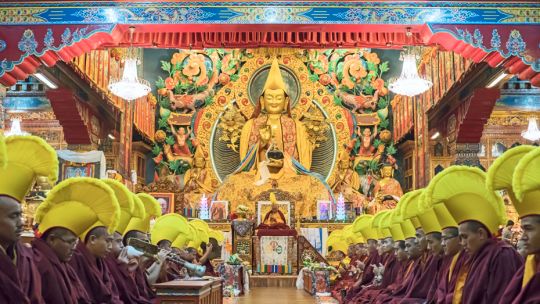
Lama Zopa Rinpoche and Kopan monks doing Guru Puja on Lama Tsongkhapa Day, Kopan Monastery, Nepal, December 2017. Photo by Ven. Lobsang Sherab.
As students of the Gelug tradition of Tibetan Buddhism, we may be familiar with the practice of Guru Puja, also known as Lama Chöpa. But how well do we understand its significance?
Now a new, multimedia online series from Lama Yeshe Wisdom Archive (LYWA), called Guru Puja is the Heart Practice, offers detailed instruction on this key practice, which was composed by Panchen Losang Chökyi Gyaltsen (1570-1662).
The six-part series contains a wealth of teachings and instructions on Guru Puja, based on teachings given by FPMT spiritual director Lama Zopa Rinpoche during the first Light of the Path retreat in the United States and augmented with similar teachings given by Rinpoche at retreats around the world.
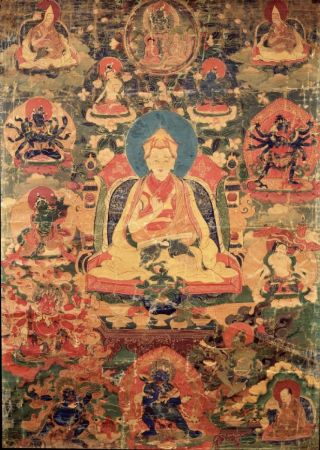
Panchen Losang Chökyi Gyaltsen. Photo © 2018 Himalayan Art Resources Inc. Photographed Image Copyright © 2004 Rubin Museum of Art.
Generations of great masters and yogi-practitioners have taken Guru Puja as the very heart of their practice. And Lama Zopa Rinpoche emphasizes to his students that they do the same.
LYWA recently published the first installment in this series, entitled “The Importance of Practicing Guru Puja,” which introduces the Guru Puja, explains why tantra is such a quick path to enlightenment, presents Rinpoche’s commentary to Pabongka Rinpoche’s heartfelt advice on the importance of practicing Guru Puja, and explains why all our meditation should be integrated into the lamrim.
Guru Puja is the Heart Practice multimedia series was edited by Ven. Sarah Thresher. The teachings are supplemented by images as well as audio and video recordings, along with links to related materials. Future installments will introduce chanting and the lineage of chanting used for Guru Puja within FPMT.
The series includes the following parts, which will be released in the coming months:
- Part One: The Importance of Practicing Guru Puja
- Part Two: An Introduction to the Chanting through to the Prostrations
- Part Three: The Offering Section
- Part Four: Renewing the Bodhisattva Vows to Mantra Recitation
- Part Five: The Tsog Offering
- Part Six: The Lamrim Prayer to the Verses of Auspiciousness
For more on Guru Puja is the Heart Practice series:
https://www.lamayeshe.com/article/lywa-multimedia-guru-puja-heart-practice
Learn more about Lama Yeshe Wisdom Archive on their website:
https://www.lamayeshe.com/index.php
FPMT.org brings you news of Lama Zopa Rinpoche and of activities, teachings and events from over 160 FPMT centers, projects and services around the globe. If you like what you read, consider becoming a Friend of FPMT, which supports our work.
21
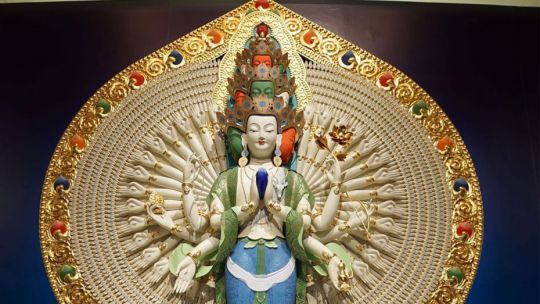
Thousand-Arm Chenrezig statue at Amitabha Buddhist Centre, Singapore, December 2017. Photo courtesy of Tan Hup Cheng.
Amitabha Buddhist Centre (ABC) in Singapore is creating a gold crown for the 3.3-meter (10.8-feet) high Thousand-Arm Chenrezig statue that occupies ABC’s main altar. The crown is the newest addition to a project that has been ongoing for more than eighteen years.
Here, ABC director Tan Hup Cheng shares a personal account of the creative endeavor:
Lama Zopa Rinpoche chose the Thousand-Arm Chenrezig statue for our main altar way back in 1995. He advised us that we must construct this statue. He further advised that we seek the services of Denise and Peter Griffin, both students of his, to build it. After a long and difficult journey, due to their many other commitments, we successfully secured Denise and Peter’s services.
Work on the statue’s parts began in 2013, with inputs from Rinpoche. After much hard work, the statue parts were completed and shipped to Singapore for assembly in August 2015. Finally, in March 2016 the statue was completed, in time for Rinpoche’s visit to ABC.
ABC’s Executive Committee had discussed the making of the crown for the Thousand-Arm Chenrezig statue, and with great devotion and lots of faith, we decided to build the crown in pure 24-carat gold. An estimate of the amount of gold required was about 4 kilograms (8.8 pounds).
In order to raise the amount of solid gold required, we sent an email to 4,000 members of ABC’s fan club. We described the unbelievable, once-in-a-lifetime opportunity and inconceivable merit, to offer a gold crown to Chenrezig.
We asked people to buy pure Swiss 999.99 finesse gold bars in denominations of 1 gram (0.4 ounces), 5 gram (1.8 ounces), 10 gram (0.4 ounces), 20 gram (0.7 ounces), 50 gram (1.8 ounces), 100 gram (3.5 ounces), or whatever amount of 24-carat gold they could afford. We told them that their gold bars would be melted down to form part of the large 4 kilograms (8.8 pound) gold crown. So for a small investment of 1 gram of gold, we explained that they would receive the same amount of merit as offering 4 kilograms of gold.
The email went viral, and people began flooding the ABC office with offerings of Swiss gold bars. After two months we had collected 4.2 kg (9.3 pounds) of pure gold.
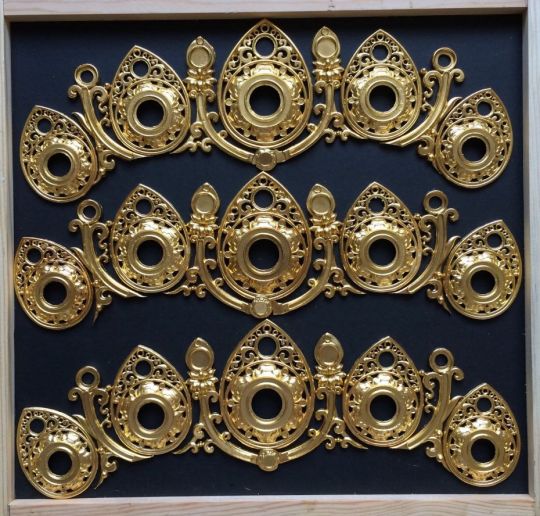
Close-up of the gold crown placed on the Thousand-Arm Chenrezig statue at Amitabha Buddhist Centre, Singapore, December 2017. Photo courtesy of Tan Hup Cheng.
Peter Griffin made the crown using the age-old technique of lost-wax casting. He had to make wax master pieces. He used computer aided programs to design the crown parts, and had the wax master pieces printed in 3D using a special machine. Peter printed a total of 169 wax pieces.
A benefactor in Singapore who owned a jewelry foundry offered his gold casting workshop equipment to us so that we could melt and cast the gold. While at Nalanda Monastery in France, Peter invited Joan, who had previously worked as a goldsmith, to come to Singapore to cast the parts into gold. Joan reached Singapore in August 2017, and successfully cast all of the 169 gold parts.
Peter is working with our benefactor jeweler so that all of the gold parts can be soldered together to form a solid three-tier crown. In sum, nine small crowns will be soldered together to form the crown for the Thousand-Arm Chenrezig statue.
Thanks to another student of Rinpoche, Piero in Italy, we managed to purchase thousands of pieces of blood red coral and turquoise stones, in various sizes to adorn the gold crown base.
When all has been completed, the gold crown will be securely locked away. We will then offer the gold crown to Rinpoche, to offer to the Thousand-Arm Chenrezig statue when Rinpoche visits in October 2019.
We believe that our guru’s pure mind can dedicate the merit created. We also believe that, as Rinpoche told me, the statue can become a cause for Dharma to flourish in this world for 10,000 years; as well as work for the FPMT; and the success of Rinpoche’s vision and wishes to be fulfilled.
To learn more about Amitabha Buddhist Centre visit their website: http://www.fpmtabc.org
FPMT.org and Mandala Publications brings you news of Lama Zopa Rinpoche and of activities, teachings, and events from over 160 FPMT centers, projects, and services around the globe. If you like what you read, consider becoming a Friend of FPMT, which supports our work.
16
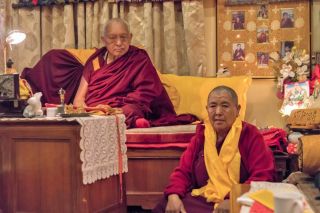
Lama Zopa Rinpoche and his sister, Anila Ngawang Samten, Nepal, February 2018. Photo by Ven. Lobsang Sherab.
Welcome to the March edition of the monthly FPMT International Office e-News!
This month we bring you:
- Highlights of Advice from Lama Zopa Rinpoche
- An Invitation to Read Our 2017Annual Review: Serving the Teachings of the Buddha
- Rejoice in Our Investment in the Entire Organization
- New Materials from Education Services
- New FPMT Study Groups
- Tara Introduced to Australia!
..and more!
The FPMT International Office News comes from your FPMT International Office. Visit our subscribe page to receive the FPMT International Office News directly in your email box.
- Home
- News/Media
- Study & Practice
- About FPMT Education Services
- Latest News
- Programs
- New to Buddhism?
- Buddhist Mind Science: Activating Your Potential
- Heart Advice for Death and Dying
- Discovering Buddhism
- Living in the Path
- Exploring Buddhism
- FPMT Basic Program
- FPMT Masters Program
- FPMT In-Depth Meditation Training
- Maitripa College
- Lotsawa Rinchen Zangpo Translator Program
- Universal Education for Compassion & Wisdom
- Online Learning Center
- Prayers & Practice Materials
- Overview of Prayers & Practices
- Full Catalogue of Prayers & Practice Materials
- Explore Popular Topics
- Benefiting Animals
- Chenrezig Resources
- Death & Dying Resources
- Lama Chopa (Guru Puja)
- Lama Zopa Rinpoche: Compendium of Precious Instructions
- Lama Zopa Rinpoche: Life Practice Advice
- Lama Zopa Rinpoche Practice Series
- Lamrim Resources
- Mantras
- Prayer Book Updates
- Purification Practices
- Sutras
- Thought Transformation (Lojong)
- Audio Materials
- Dharma Dates – Tibetan Calendar
- Translation Services
- Publishing Services
- Teachings and Advice
- Find Teachings and Advice
- Lama Zopa Rinpoche Advice Page
- Lama Zopa Rinpoche: Compendium of Precious Instructions
- Lama Zopa Rinpoche Video Teachings
- ༧སྐྱབས་རྗེ་བཟོད་པ་རིན་པོ་ཆེ་མཆོག་ནས་སྩལ་བའི་བཀའ་སློབ་བརྙན་འཕྲིན།
- Podcasts
- Lama Yeshe Wisdom Archive
- Buddhism FAQ
- Dharma for Young People
- Resources on Holy Objects
- Ways to Offer Support
- Centers
- Affiliates Area
- Teachers
- Projects
- Charitable Projects
- Make a Donation
- Applying for Grants
- News about Projects
- Other Projects within FPMT
- Support International Office
- Projects Photo Galleries
- Give Where Most Needed
- FPMT
- Shop
Translate*
*powered by Google TranslateTranslation of pages on fpmt.org is performed by Google Translate, a third party service which FPMT has no control over. The service provides automated computer translations that are only an approximation of the websites' original content. The translations should not be considered exact and only used as a rough guide.It’s the foggy mind, the mind that’s attracted to an object and paints a distorted projection onto it, that makes you suffer. That’s all. It’s really quite simple.







